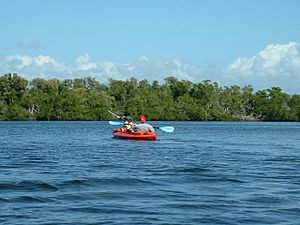Estero Bay (Florida) facts for kids
Estero Bay is a beautiful and important estuary on the west coast of Florida. It's located southeast of Fort Myers Beach. An estuary is a special place where fresh water from rivers mixes with salty ocean water. Estero Bay is an inlet of the Gulf of Mexico. It is long, very shallow, and covers about 15 square miles (39 km²).
The bay is protected on its western side by a string of barrier islands. These islands include Estero Island, Long Key, Lovers Key, Black Island, Big Hickory Island, and Little Hickory Island. Four natural openings connect the bay to the Gulf of Mexico. These are Matanzas Pass, Big Carlos Pass, New Pass, and Big Hickory Pass. Several towns are located around the bay, such as Estero, Bonita Springs, and Fort Myers Beach. Two rivers, the Imperial River and the Estero River, flow into the bay, bringing fresh water. The daily tides are very important for all the plants, crabs, fish, and other animals that live here. Estero Bay is also home to the historic Mound Key Archaeological State Park.
Protecting Estero Bay
Estero Bay is a very special natural area. Because of its importance, the northern part of the bay was made Florida's first state aquatic preserve in December 1966. This means it is a protected area where nature can thrive. Later, in 1983, the southern part of the bay was also added to this preserve. This was decided by the Florida Legislature, which is the group of lawmakers who create laws for the state of Florida. Protecting the bay helps keep its waters clean and safe for all the wildlife that depends on it.
Mound Key and Ancient History
Mound Key is an island in Estero Bay with a rich history. For a long time, people thought it might have been the main city of the ancient Calusa people. The Calusa were a powerful Native American group who lived in southwest Florida. In 2020, archaeologists found exciting proof that confirmed this idea. They discovered that Mound Key was the site of Fort San Antón de Carlos. This was a Spanish fort built a long time ago. It was also one of the first places where Jesuit missionaries lived in North America. This discovery helps us understand more about the Calusa people and the early history of Florida.


